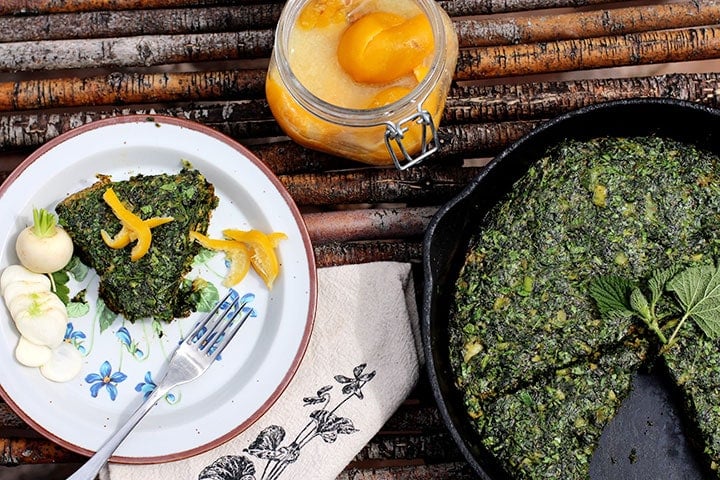Several weeks ago a friend mentioned she was looking for a good home for her chickens. I immediately jumped at the opportunity! We brought them home in a metal cage in the back of our Subaru Outback and it took me all of about five minutes to fall in love with them.
We showed them their new home and gave them botanical names. By the next day we had fresh eggs in the roost. And then more eggs and more eggs, and so…
…I’ve been seeking out new and fun ways to enjoy eggs!
A few weeks back I saw a demonstration of someone preparing kuku sabzi, a Persian frittata. I immediately got excited about the large amount of chopped greens in the recipe. Combine that with eggs, and it seems like the perfect springtime dish!
The original recipe I saw called for parsley, cilantro, and fresh dill, but I wanted to go a bit wilder, so I created a frittata recipe also featuring nettles and chickweed. None of the cilantro at the store looked great, so I omitted that. Which brings me to my point that there is a lot of possibility for variation when choosing your greens for this frittata. Just be sure that if you are using wild greens that you have a 100% positive ID for every plant you eat.
Before we get to the frittata recipe, let’s take a look at the herbs, spices, and ingredients.
Nettle (Urtica dioica)
Incredibly nutrient-dense, this delicious and wild spring green is a favorite of herbalists and wild foragers alike. Regularly eating nettle can strengthen your bones, teeth, and hair. Many people drink nettle nourishing infusions to reduce seasonal allergy symptoms, and a fresh extract of nettle leaf has been shown to regulate blood glucose levels and inflammation levels.1234 A great example of food as medicine!
How to Identify and Harvest Nettle
Nettle likes to grow in moist places with full sun to part shade. It likes disturbed ground and protein rich soils. Nettle grows as single stalks with opposite leaves that are heart shaped with a toothed edge. The whole plant is covered in stinging hairs which can leave a mild to moderate stinging rash when you brush up against it.
The leaves are best harvested when the plant is quite young. I like to harvest the young tops, leaving behind several sets of leaves, which allows the plant to continue growing.
To avoid being stung, use gloves when harvesting nettle. You get the worst nettle stings when you lightly brush up against the plant. I find that pinching them off with a firm grip helps me to avoid most, but not all, of the sting.
Nettles should not be harvested for food after the plant goes to flower, as the leaves of the older plant may be irritating to the kidneys.
Chickweed (Stellaria media)
Chickweed is a tender spring green that you can eat fresh from the garden. It is nutrient dense and mineral rich, making it a great plant to extract with vinegar. This plant quickly fades when dried, so it’s best to use it as much as you can fresh during its brief spring showing. (In my hot and dry climate, chickweed withers away during the summer months.)
How to Identify and Harvest Chickweed
Chickweed is a low growing herbaceous plant that thrives in cool and moist conditions and grows readily in disturbed soil.
Chickweed’s small white flowers look like they have ten petals, but they technically only have five petals with a deep divide in each petal. The flowers are said to look like a star and the genus name, Stellaria, means star-like.
The leaves are oval and grow opposite along the stem.
The best distinguishing trait of chickweed is something you may need a magnifying glass or botanical loupe to see. Take a very close look at the stem of chickweed and you’ll see a row of tiny hairs that grow along one side of the stem. With each leaf node, the row of hairs shifts to the next side of the stem.
It’s best to eat chickweed when it’s still young. Harvest it before it flowers, or just as it is coming into bloom. Chickweed that has gone to seed may be too tough or stringy to be enjoyable to eat.
The plant has easily disturbed roots, so the best way to harvest the plant is with scissors. Simply cut several inches from the top, leaving enough stems and leaves for the plant to continue growing. Chickweed will grow back with a flourish after each harvest!
Parsley (Petroselinum crispum)
Parsley is high in many nutrients especially flavones, vitamin K1, vitamin C, and beta carotene. While most of us are familiar with having a leaf or two decorating our dinner plates, to get the most benefits of this nutrient dense plant, you’ll want to eat a lot more than a couple of nibbles. This recipe is a great way to enjoy lots of parsley. Consider saving a few leaves as an edible garnish, too!
Dill (Anethum graveolens)
Fresh dill leaves are a deliciously aromatic and they give this frittata a unique and tempting flavor. Dill is high in numerous phytochemicals like quercetin and limonene. If you don’t grow dill yourself, you can often find it in the fresh herb section of your grocery store.
Eggs
Eggs are a wonderful source of protein as well as vitamins A, D, and E, and phytonutrients such as choline and zeaxanthin.5 They are often recommended to support eye health since they contain an abundance of lutein, a valuable nutrient for the eyes.6
Turmeric (Curcuma longa)
Turmeric offers so many benefits, especially for modulating inflammation, that I like to use it in practically every meal I make.
Cumin Seed (Cuminum cyminum)
Cumin is a popular spice that people mainly use for culinary purposes in the United States, but it has a long history of medicinal use in other parts of the world. This is my husband’s favorite spice, and he uses it in everything from our morning egg dishes to meat and vegetable curries.
Black Pepper (Piper nigrum)
Adding black pepper to your meals has the potential to increase the bio-availability of the nutrients. This means you are able to better digest and absorb your food! I keep a pepper grinder close to the stove so I can add black pepper to practically everything.
Scallions and Garlic
People have used scallions and garlic for thousands of years as both food and medicine. Garlic may be one of our oldest cultivated plants. Both plants are high in sulfur compounds that support gut health, aid digestion, and add a delicious flavor to foods. Scallions have as much as 140 times more phytonutrients than onions!7 The green stems are higher in nutrients than the bulbs themselves, so be sure to use the entire plant.
Wild Greens Persian-Style Frittata
Kuku sabzi, a Persian frittata that uses a lot more greens than you can typically find in a frittata, inspired this recipe. The result is a light and delicious way to enjoy the gifts of spring. This is a very forgiving frittata recipe that is open to many variations. Use whatever greens may be lurking in your refrigerator or growing strong in the garden.
What you’ll need…
- 6 tablespoons olive oil, divided
- 1 teaspoon black pepper
- 1 teaspoon turmeric
- 7 large sliced scallions, including the green parts
- 1/2 teaspoon cumin seeds
- 6 large eggs
- 1 1/2 teaspoons salt
- 3 garlic cloves, minced
- 1 teaspoon baking powder
- 1 cup finely chopped chickweed
- 2 cups finely chopped nettle leaves (use gloves when chopping to avoid the sting)
- 1 1/2 cups finely chopped parsley
- 1 cup finely chopped dill leaves
In a large broiler-safe skillet, heat 3 tablespoons of olive oil on medium-high heat. Add the scallions and sauté for 3 to 5 minutes or until they soften and the white parts become translucent. Add the minced garlic cloves, black pepper, turmeric, and cumin seeds and sauté for one minute more. Remove from heat.


In a medium-sized bowl mix the eggs, salt, and baking powder. Whisk until well combined and a bit frothy.


Add all of the finely chopped greens as well as the scallions, garlic and spice mixture to the eggs. Stir well.
Heat the remaining 3 tablespoons of olive oil in the broiler-safe skillet. Pour the mixture into the skillet and spread evenly.
Cook on medium heat, covered, for 8 to 10 minutes or until the bottom is set.
Uncover the skillet and place it in the broiler for 1 to 2 minutes or until it is cooked through. Don’t walk away from it while it is in the broiler – keep checking it until it is done.
Serve while warm – also delicious as cold leftovers. We enjoyed ours with preserved lemons and white turnips.
Yield: Serves 4 to 6 people depending on serving size.
Now I’d love to hear from you!
Do you cook with nettle, chickweed, or other wild greens?
What are some of your favorite recipes?
Let me know in the comments below.






















